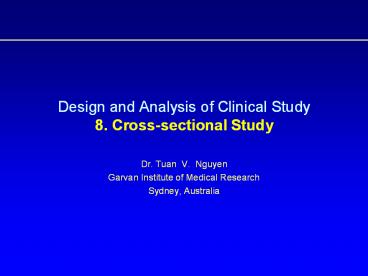Design and Analysis of Clinical Study 8. Cross-sectional Study - PowerPoint PPT Presentation
Title:
Design and Analysis of Clinical Study 8. Cross-sectional Study
Description:
Design and Analysis of Clinical Study 8. Cross-sectional Study Dr. Tuan V. Nguyen Garvan Institute of Medical Research Sydney, Australia Cross-sectional Study Cross ... – PowerPoint PPT presentation
Number of Views:290
Avg rating:3.0/5.0
Title: Design and Analysis of Clinical Study 8. Cross-sectional Study
1
Design and Analysis of Clinical Study 8.
Cross-sectional Study
- Dr. Tuan V. Nguyen
- Garvan Institute of Medical Research
- Sydney, Australia
2
Cross-sectional Study
- Cross-sectional studies are studies of
prevalence. Proportion with an attribute or
disease / Number of subjects Prevalence. - 3 important questions to consider
- Definition of Case
- Definition of the Population
- Are cases and non-cases from an unbiased sample
of the population?
3
Preparing Cross-sectional Study
- In Cross-sectional studies think of
- Sampling Procedures.
- Clear definition of Target Population.
- Clear definition of outcome.
- Clear definition of risk factors.
- Remember Confounders.
- Remember seasonal variations.
4
Uses of Cross-sectional Study
- Identify and describe a problem
- Collect information for planning e.g. surveys of
immunisation, antenatal care, coverage - Evaluate utilisation rates of services
- Monitoring health status of a community by
regular repeated surveys
5
Using Cross-sectional Studies for Hypotheses
Formulation
- Method of Difference.
- If frequency of a disease is markedly different
between two groups then it is likely to be caused
by a particular factor that differs between them. - Method of Agreement.
- If a factor commonly occurs in which a disease
occurs with high frequency then the factor is
very likely associated with the disease. - Concomitant variation. Frequency of a factor
varies in proportion to frequency of disease.
6
Surveys
- Surveys are a form of cross-sectional studies
used for - Assessing attitudes, opinions or beliefs
- To study characteristics of populations regarding
behaviour e.g. health service utilisation drug
use smoking alcohol consumption etc. - Information about socio-demographic
characteristics
7
Modification of Cross-sectional Study I
Trend Design
Future
Sampling
Population
Risk Factor
Present
Disease Prevalence
Risk Factor
Sampling
Disease Prevalence
8
Modification of Cross-sectional Study II
Panel Design
Present
Future
Risk Factor
Risk Factor
Population
Disease Prevalence
Disease Prevalence
Same Sample
Sample
9
Sample Size
General formula of sample size for 1 group
General formula of sample size for 2 groups
Constant C associated with Type I and Type II
Errors
a b 0.20 (Power 0.80) b 0.10 (Power 0.90) b 0.05 (Power 0.95)
0.10 6.15 8.53 10.79
0.05 7.85 10.51 13.00
0.01 13.33 16.74 19.84
10
Sample Size for One Parameter
- Case 1. We want to estimate the average height of
Vietnamese men. - We accept an error of 1 cm (d 1)
- 95 confidence interval (or a0.05) and power
0.8 (b 0.2). - Previous data suggest that the standard deviation
of height was 4.6 cm. - The sample size is
11
Sample Size for One Parameter
- Case 2. We want to estimate the prevalence of
smokers in the population. - We accept an error of 2
- Previous data suggest that the prevalence is
around 70 - The minimal sample size is 2017
12
Sample Size for Comparing Two Groups
- In case-control study the data are usually
summarized by an odds ratio (OR), rather then
difference between two proportions. - If p1 and p2 are the proportions of cases and
controls, respectively, exposed to a risk factor,
then
- If we know the proportion of exposure in the
general population (p), the total sample size N
for estimating an OR is
- Where r n1 / n2 is the ratio of sample sizes
for group 1 and group2 p is the prevalence of
exposure in the controls and OR is the
hypothetical odds ratio. If n1 n2 (so that r
1) then the fomula is reduced to
13
Sample Size for Comparing Two Groups
- Example The prevalence of vertebral fracture in
a population is 25. It is interested to
estimate the effect of smoking on the fracture,
with an odds ratio of 2, at the significance
level of 5 (one-sided test) and power of 80. - The total sample size for the study can be
estimated by
14
Advantages and Disadvantages of Cross- sectional
Studies
- Advantages
- Useful for descriptive studies
- Rapid, inexpensive, can provide analytic clues.
- Less prone to error about exposure recall and
bias
- Disadvantages
- Unable to sort out what came first exposure or
outcome - Prone to sample distortion bias.
15
Analysis of Cross-sectional Studies
- Descriptive analyses
- Analysis of differences
- Analysis of association / relationship
- Multivariable analysis































